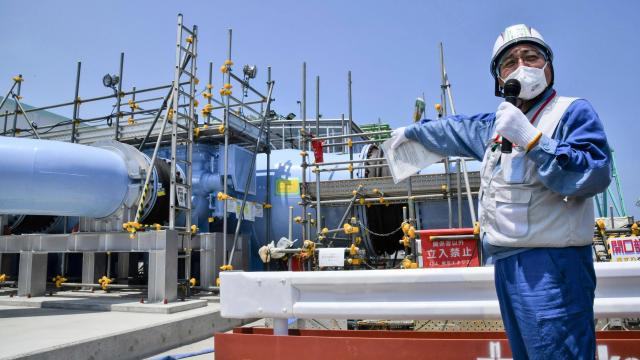Everything is in place to begin dumping treated radioactive wastewater from Japan’s destroyed Fukushima Daiichi power plant into the ocean, according to the plant’s operator. The plan to do so has been in the works for years, as irradiated water has accumulated in the aftermath of 2011’s earthquake, tsunami, and subsequent nuclear meltdown. But now the wastewater release appears imminent.
This week, Tokyo Electric Power Holdings (TEPCO) said it had completed construction on all of the necessary infrastructure and equipment to discharge the water offshore, as reported by the Associated Press. A final bit of undersea tunnel was the last thing to be installed. The only barrier remaining at this point is bureaucracy. TEPCO is simply waiting on the outcome of a final safety inspection from national regulators, which is scheduled to begin Wednesday.
If all goes according to plan, TEPCO officials told AP, they expect to be allowed to start discharging the treated wastewater one week from the end of the inspection — sometime this summer.
The basic idea is that TEPCO will slowly release its stored radioactive wastewater over the next thirty years. The plant operators have been treating the water to minimise its radioactivity, but not all of the harmful compounds can be taken out. A radioactive isotope called tritium — considered a relatively weak and less harmful source of radiation — carbon-14, and other trace materials remain. By further diluting the wastewater with seawater at a ratio of less than 1:100, and controlling its release, Japanese officials and the plant operator have said that the radiation concentrations in the discharged waste will be near background levels, comparable to what operational nuclear power plants release, and less than the benchmark levels for drinking water safety, according to a report from Nature.
Though others aren’t so sure of that plan, and remain sceptical. TEPCO’s news comes in spite of significant, continued international opposition to discharging the wastewater — particularly from Japan’s neighbouring countries like South Korea, China, and Pacific island nations. There’s also been local protest from fishing groups, who have already suffered losses amid prohibitions against seafood caught in the region. Adding to the pile of critiques and concerns, some scientists have expressed fears and uncertainty about the potential for long-term marine health impacts. The U.S. National Association of Marine Laboratories, for instance, formally announced its opposition to the ocean dumping scheme in December 2022.
Yet TEPCO maintains that releasing the wastewater is a necessity. The company has said it’s set to run out of storage space for the radioactive water early next year. Critics have suggested the plant operator could simply acquire more space and build more storage capacity. But TEPCO and the Japanese government contend that the more water is held in storage and the longer it is kept, the higher the risk of large-scale leaks or spills — another earthquake or tsunami is a perennial concern. The International Atomic Energy Agency has also supported the country’s wastewater dumping proposal.
In March 2011, a 9.0 earthquake — Japan’s strongest in recorded history — triggered a massive tsunami that killed more than 18,000 people and decimated the cooling system at Fukushima Daiichi nuclear plant on the country’s eastern coast. The quake, tsunami, and resulting damage ultimately lead to the meltdown of three of Fukushima’s reactors.
To cool the ruined reactors and prevent an even more calamitous outcome, plant operators immediately began pumping seawater over the overheated fuel cores. That process continues, to this day. Ongoing cooling efforts produce an additional ~170 tons of contaminated wastewater every 24 hours. More than 1.25 million tons of radioactive water have already piled up. International consensus or not, all of that water has to go somewhere.
